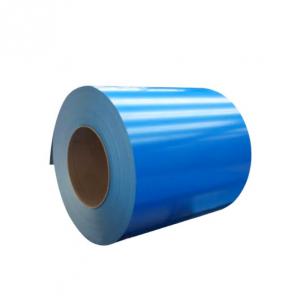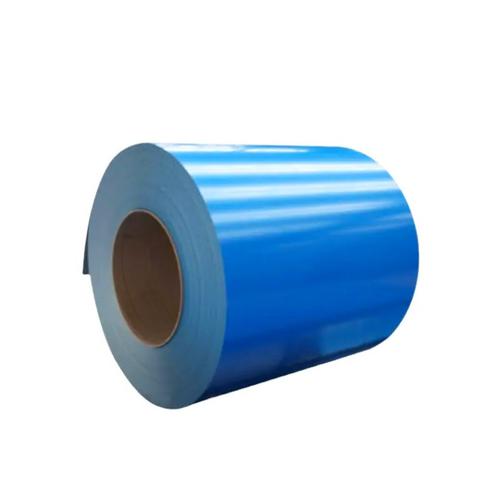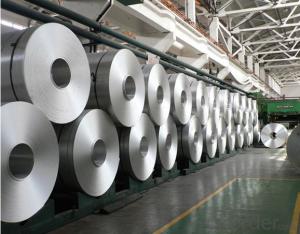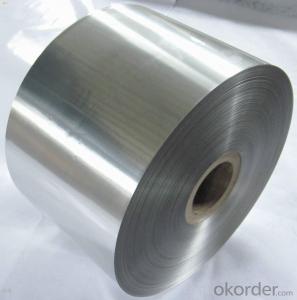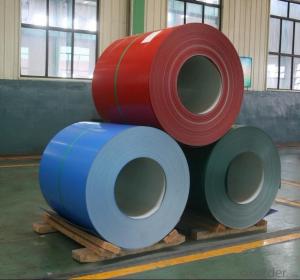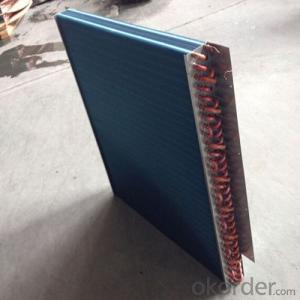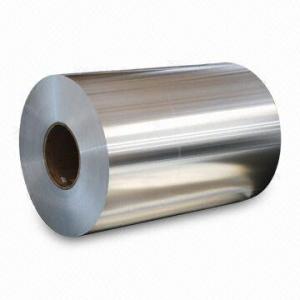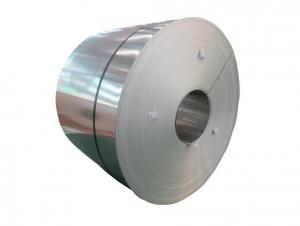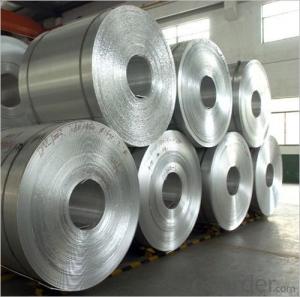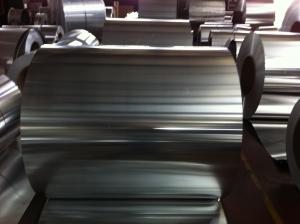PE PVDF Color-coated Aluminum Coil 1100 3003 5052 5083 Construction/Transportation/Packaging
- Loading Port:
- Qingdao
- Payment Terms:
- TT OR LC
- Min Order Qty:
- 1 T
- Supply Capability:
- 200 T/month
OKorder Service Pledge
OKorder Financial Service
You Might Also Like
Specification
What is color-coated aluminum coil?
After the aluminum coil is cleaned, chromized, roller-coated, and baked, the surface of the aluminum coil is coated with paint of various colors, which is color-coated aluminum coil.
Colored aluminum is widely used in aluminum-plastic panels, honeycomb panels, insulation panels, aluminum curtain walls, blinds, roller shutters, aluminum-magnesium-manganese roofing systems, aluminum ceilings, household appliances, downspouts, aluminum cans and many other fields due to its advantages of light texture, bright colors, easy processing and no rust.
Classification of color-coated aluminum coils:
1. Due to different processing processes and purposes of use, it can be simply divided into:
Because of the paint applied on the surface, it is divided into polyester (PE) coated aluminum coils and fluorocarbon (PVDF) coated aluminum coils; epoxy roller-coated aluminum coils. Of course, there are also cases where one side is coated with fluorocarbon and the other side is coated with polyester; there are even cases where both sides are coated with fluorocarbon;
2. Coating thickness:
Single coating (4-20 microns); double coating (25-28 microns); triple coating (35-38 microns)
3. Surface pattern:
Also known as wood grain aluminum coil, stone grain aluminum coil, brick pattern, camouflage aluminum coil, fabric aluminum coil, etc.!
4. Application:
Roofing material (aluminum magnesium manganese roofing system), ceiling material (aluminum alloy ceiling), brushed plate (surface brushed), etc.
Advantages of color-coated aluminum coil:
1. Light weight: The density of aluminum is only 1/3 of that of steel, which is convenient for transportation and construction.
2. Strong corrosion resistance: The surface coating can effectively resist erosion by environmental factors such as wind, rain, and ultraviolet rays.
3. Diverse colors: Various colors and patterns can be customized according to needs to enhance the decorative effect.
4. Excellent processing performance: Easy to bend, stamp, cut and form to meet diverse design needs.
5. Good temperature resistance: The melting point of aluminum is 660 degrees, and the general temperature cannot reach its melting point.
6. Environmental protection: Aluminum can be 100% recycled, which meets the requirements of sustainable development.
Coated aluminum alloy coil specifications:
| Alloy | 1050, 1060, 1070, 1100, 1145, 1200, 3003, 3004, 3005,3105, 5005, 5052, 5083, 5182, 5754, 6061, etc. |
| Temper | O, H12, H14, H16, H18, H22, H24, H26, H34, H32, H36, H111, H112, etc. |
| Thickness | 0.25-4.5mm |
| Width | 100-1600mm |
| Length | 100-16000mm |
| Material process | CC/DC |
| Coating material | polyvinylidene fluoride, polyethylene, epoxy resin, polyurethane |
| Color | red, blue, yellow, orange, green, etc. RAL Color or customization |
| Application | construction, aluminum-plastic panels, decoration, roofs, molds, automobiles, lighting, electronic products, etc. |
| MOQ | 1-3 tons |
Application of coated aluminum coils:
1. Construction field: used as exterior walls, roofs, curtain walls, etc., providing rich colors and styling designs, commonly seen in commercial projects and gymnasiums.
2. Home appliance field: used for home appliance housings such as refrigerators and air conditioners, with beautiful appearance and corrosion resistance.
3. Advertising field: making billboards and signboards, colorful and durable, suitable for outdoor use.
4. Electronic and electrical field: used for computer cases and electrical panels, with conductivity and heat dissipation, protecting internal components.
5. Transportation field: used for the housings of vehicles such as cars and trains, lightweight to improve fuel efficiency.
6. Other fields: used in luggage, solar reflectors and air conditioning ducts, etc., showing broad prospects.
Why choose Hongchang Aluminum?
1. Large scale: has two major production bases in Gongyi and Zhengzhou, Henan, employing hundreds of high-tech technicians.
2. Advanced technology: introduces advanced foreign technology and conducts research and development through field operations.
3. Direct hit the bottom price: direct sales by manufacturers, eliminating middlemen, customers can enjoy affordable prices.
4. Independent logistics: provide logistics arrangements, customers can choose customized logistics methods.
5. Perfect after-sales: provide long-term tracking and return visits, and solve customer problems in time.





Packaging:
The board/roll is placed on an iron or wooden pallet, perfectly wrapped with waterproof kraft paper, and then fixed with an iron narrow band.

- Q: Can aluminum coils be used for architectural applications?
- Yes, aluminum coils can be used for architectural applications. Aluminum is a versatile and lightweight material that is commonly used in construction due to its durability, corrosion resistance, and ease of installation. It can be formed into coils and used for various architectural elements such as roofing, cladding, facades, gutters, and window frames.
- Q: What are the thermal conductivity properties of aluminum coils?
- Aluminum coils have high thermal conductivity properties, which means they are efficient in transferring heat.
- Q: What is the role of aluminum coils in the construction of ships?
- Aluminum coils are used in the construction of ships primarily for their lightweight and corrosion-resistant properties. They are commonly used in the fabrication of ship hulls, decks, and superstructures. The use of aluminum coils reduces the overall weight of the ship, improving fuel efficiency and increasing payload capacity. Additionally, the corrosion resistance of aluminum helps to prolong the lifespan of the ship, reducing maintenance costs in the long run.
- Q: How do aluminum coils compare to other metals in terms of strength?
- Aluminum coils have excellent strength-to-weight ratio compared to many other metals. While aluminum is not as strong as steel, it is lighter and more flexible, making it a popular choice in various applications. Aluminum coils can withstand significant forces without breaking or deforming, making them suitable for a wide range of industries, including automotive, aerospace, and construction. Additionally, aluminum coils have good corrosion resistance, which further enhances their durability and longevity. However, it is important to note that the strength of aluminum can vary depending on the alloy and temper used, so specific comparisons should be made based on the particular application and requirements.
- Q: What are the factors that affect the cost of aluminum coils?
- There are several factors that can affect the cost of aluminum coils. 1. Raw material costs: The cost of aluminum, which is the primary material used in manufacturing coils, can fluctuate based on global supply and demand as well as market conditions. Changes in the price of aluminum can have a direct impact on the cost of aluminum coils. 2. Manufacturing process: The production process involved in making aluminum coils can also impact their cost. Various techniques such as casting, rolling, and annealing are used, and each method has its own associated costs. The complexity and efficiency of the manufacturing process can influence the final price of the coils. 3. Size and specifications: The size, thickness, and specifications of the aluminum coils can affect their cost. Larger coils or coils with specific dimensions may require additional raw materials, processing time, or specialized equipment, which can contribute to higher costs. 4. Surface finish: The type of surface finish applied to the aluminum coils can also impact their cost. Coils with a higher-quality finish, such as brushed or coated surfaces, may be more expensive due to the additional processing and materials required. 5. Quantity and order volume: The volume of aluminum coils ordered can often impact the cost. Larger order quantities may lead to economies of scale, resulting in lower unit costs. Conversely, smaller orders or customized specifications may incur additional setup costs or higher per-unit prices. 6. Market competition: The level of competition in the aluminum coil industry can affect pricing. If there are numerous manufacturers offering similar products, prices may be more competitive as companies strive to attract customers. On the other hand, if there are limited suppliers or unique product offerings, prices may be higher due to reduced competition. 7. Transportation and logistics: The cost of transporting aluminum coils can also influence their overall price. Factors such as distance, mode of transportation, and fuel prices can impact shipping costs, which in turn can be passed on to customers. It is important to note that these factors are not exhaustive and can vary depending on the specific circumstances and market dynamics. Additionally, other external factors such as taxes, tariffs, and government regulations can also affect the cost of aluminum coils.
- Q: What are the different grades of aluminum used in coils?
- Coils utilize various grades of aluminum, each boasting unique properties and applications. Notable grades encompass: 1. The 1000 series, a commercially pure aluminum, excels in fighting corrosion. It finds its niche in chemical processing devices and marine components, where corrosion resistance reigns supreme. 2. The 3000 series alloys shine with moderate strength and impressive formability. Their versatility sees them employed in cooking utensils, heat exchangers, and general sheet metal fabrication. 3. The 5000 series grade impresses with its weldability and corrosion resistance. Marine settings, transportation, and structural components all benefit from its presence. 4. The 6000 series alloys blend strength, formability, and corrosion resistance. As a result, they abound in architectural applications - window frames, doors, and curtain walls. 5. The 7000 series grade touts high strength and toughness. It's a favorite contender within aerospace, sporting goods, and automotive realms, where robustness is paramount. These examples merely scratch the surface of the aluminum grades employed in coils. Selecting the appropriate grade hinges on application-specific criteria like strength, corrosion resistance, formability, and weldability.
- Q: Are aluminum coils suitable for insulation jacketing?
- Yes, aluminum coils are suitable for insulation jacketing. Aluminum is a highly durable and corrosion-resistant material that can effectively protect insulation materials from external elements. Additionally, aluminum coils offer excellent heat and moisture resistance, making them an ideal choice for insulation jacketing applications.
- Q: wikipedia says welding aluminum by means of stick welding is possible but i have always been told TIG is the only way to weld aluminum. what do i need in order to stick weld aluminum? BTW i have a Lincoln Electric AC 225 Stick Welder
- you can weld aluminum with stick, tig, or mig processes. We use mig to weld aluminum bus sections for power houses. I agree that stick is a difficult way to weld aluminum and the results are often less than desirable. Look into renting a mig machine and getting the proper gas and wire.
- Q: What are the different surface protection options available for aluminum coils?
- There are several surface protection options available for aluminum coils, depending on the specific requirements and applications. 1. Paint Coating: One of the most common methods of surface protection is applying a paint coating on the aluminum coil. This provides a protective layer that helps prevent corrosion, oxidation, and damage from environmental factors. Additionally, paint coatings can offer aesthetic appeal and come in various colors and finishes. 2. Anodizing: Anodizing is an electrochemical process that creates a durable and corrosion-resistant oxide layer on the surface of the aluminum coil. This method not only enhances the coil's resistance to wear and tear but also provides a decorative appearance. Anodized coatings can be clear or colored, offering flexibility in design options. 3. Film Protection: Applying a protective film on the surface of the aluminum coil is another common option. These films are typically made of plastic or vinyl and provide a temporary layer of protection during transportation, handling, and installation. They safeguard against scratches, abrasions, and other minor damages before being removed. 4. Powder Coating: Powder coating involves the electrostatic application of a dry powder onto the aluminum coil's surface. The powder is then cured under heat, resulting in a durable and resilient protective layer. Powder coatings are known for their excellent resistance to chemicals, UV rays, and physical impacts. 5. Cladding: Cladding, also known as laminating, involves bonding a protective layer, such as PVC, onto the aluminum coil's surface. This method provides enhanced resistance against scratches, impact, and weathering. Cladding can offer additional benefits, such as thermal insulation and noise reduction. These surface protection options vary in terms of cost, durability, appearance, and specific application requirements. It is essential to consider factors such as the intended use, environmental conditions, and desired aesthetics when selecting the most suitable surface protection option for aluminum coils.
- Q: Can aluminum coils be used for electrical wiring?
- Yes, aluminum coils can be used for electrical wiring. Aluminum is a good conductor of electricity and has been used for electrical wiring in the past. However, it is important to note that aluminum wiring is not as commonly used as copper wiring due to some concerns. Aluminum has a higher resistance than copper, which may lead to increased power losses and heating. It also has a tendency to oxidize, causing potential fire hazards. To mitigate these issues, special precautions need to be taken when using aluminum wiring, such as using larger gauge wires and using connectors specifically designed for aluminum. Copper wiring is generally preferred for its lower resistance and better conductivity, but aluminum wiring can still be used if proper precautions are taken.
Send your message to us
PE PVDF Color-coated Aluminum Coil 1100 3003 5052 5083 Construction/Transportation/Packaging
- Loading Port:
- Qingdao
- Payment Terms:
- TT OR LC
- Min Order Qty:
- 1 T
- Supply Capability:
- 200 T/month
OKorder Service Pledge
OKorder Financial Service
Similar products
Hot products
Related keywords
